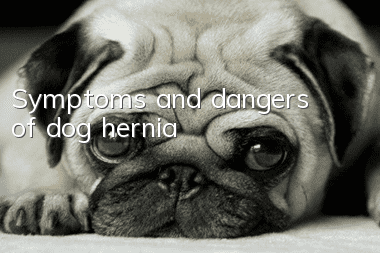Symptoms and dangers of dog hernia

The main clinical symptoms of dog hernia are: abdominal masses, abdominal pain and other symptoms may appear in various parts of the body. After a dog has a hernia, the normal tissues of the body will leak into the hernia hole. If this happens in the long term, it will cause necrosis of some tissues in the dog. If a hernia occurs in the dog’s abdomen, it is very likely to cause intestinal obstruction or intestinal necrosis to the dog. It is recommended that the owner take the dog to the pet hospital for surgery in time to suture the dog's hernia hole.
Dogs suffer from hernia diseases, and the symptoms and harm they show are also related to the location of the hernia.
1.Hiatal hernia
When a dog suffers from a hiatal hernia, the contents of the hernia are usually organs in the abdominal cavity, such as the stomach, intestines, etc. Since a large amount of the hernia contents compress the dog's esophagus and trachea, it will cause obvious vomiting, Shortness of breath.
2. Perineal hernia
If a dog's hernia occurs in the perineal area, it may cause the dog to have difficulty defecating. If the content of the hernia is the bladder, it may also cause the dog to be unable to urinate.
3. Umbilical hernia
Umbilical hernia is located at the belly button of the dog. It mostly occurs in puppies under five months of age. It looks like a localized protrusion. It is soft to the touch, has a wavy feeling, is painless and heatless, and can be recovered by pressing, but will return to its original state after letting go. . It usually causes harm to dogs such as vomiting, loss of appetite, increased body temperature, and pain when touching the affected area. In addition, intestinal gas or constipation may occur. Changing the body position or applying pressure with hands cannot make the swelling disappear.
4. Inguinal hernia
Inguinal hernia is more common in female dogs between 2 and 6 months old. A swollen mass can be seen in the groin. In the later stages of the disease, the swelling will gradually increase in size and harden. It may cause abdominal pain, vomiting or difficulty in defecation in dogs.
- Emergency treatment for dog fractures
- The feared pit bull, how to train a pit bull not to bite?
- How to take better care of dog hair
- What should I do if my dog eats whatever others give me? How to train my dog to refuse food?
- Why do dogs run crazy suddenly?
- What should I do if my dog is picky about food? Don’t starve it!
- What is the average lifespan of an Australian Shepherd?
- Is it okay to postpone the dog’s vaccination for a few days?
- What kind of pet snacks should I choose? Freeze-dried snacks are a good choice!
- Dog hair loss is divided into physiological and pathological causes. Click here to see which type your dog belongs to?



